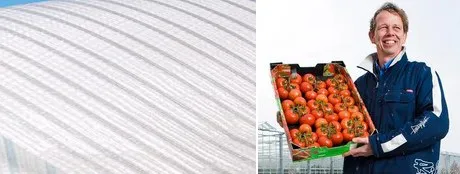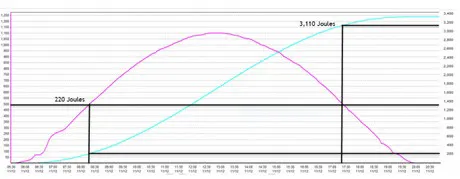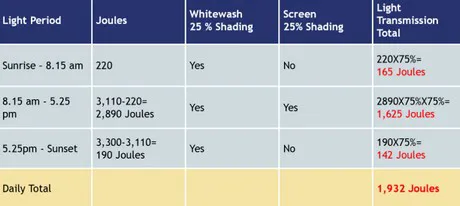If air-exchange is the main means of cooling a glasshouse, how does a grower keep the semi-closed glasshouse cool? Besides fan speed, which has a negative effect on climate, and evaporative cooling there is one other important tool to keep the temperature low, Godfrey Dol of Glasshouse Consultancy explains.

The answer to the question is shading. In a conventional glasshouse, shading is the least preferred method for cooling. It is easy to understand why. In cool climates, the general perception is that 1% light equals 1% production. Shading takes away light and reduces yield. But what if you receive more than 3000 Joules of light in a desert or subtropical climate? Is the plant able to convert all those joules into grams of fruit?
In general, growers now accept that a tomato plant needs 1700-2000 joules per day to achieve maximum production. Similar levels are true for peppers and lettuce. In fact, in the Dutch summers, the average light sum has a similar range. Growers in Australia receive almost twice as much light compared to growers in the Netherlands. But they struggle to achieve the Dutch yields. Still, they are reluctant to use shading, because in a conventional glasshouse, the air exchange is impeded. The air underneath the screen becomes stagnant creating a poor climate for plants.
In a semi-closed glasshouse, the air enters the glasshouse from below. When a shade screen is closed, the air is pushed through the screen (or a gap - helpful to keep the airflow in a glasshouse), to the vents and leaves the glasshouse. There is no staleness of the air, as the fans keep pushing the air up towards the vents. In fact, a shade screen acts as a membrane, distributing the air more evenly as it passes through the screen, creating a more even temperature. In a semi-closed glasshouse, air is always moving and activating transpiration.
If we accept that 1800 joules are needed to achieve maximum production, shading is an excellent way to reduce the heat in the semi-closed glasshouse. Less heat coming into the glasshouse means less fan speed.
Can we reduce light and heat without losing yield?
To answer that question, let’s consider a 3300 Joule day. This is very unusual in cool climates, but a frequent occurrence in warmer climates. The graph below shows a perfectly sunny day, reaching a maximum of 1100 watts light intensity (pink line, left hand scale) and a total light sum of more than 3300 joules (blue line, right hand scale).

The glasshouse already has 25% chalk on the roof to reduce radiation and the grower has access to a 25% shade screen. The grower decides to close the screen at 500 watts. This might seem too aggressive, but let’s try to calculate the amount of light that is shaded away. From sunrise to 500 watts, 25% of the accumulated is stopped from reaching the plants. The light sum at that stage is 220 joules, so 55 joules are blocked, and 165 joules reach the crop. At 500 watts the screens close and 50% of the light is blocked. In the table underneath the calculations are presented for the full day.

It turns out that from the 3300 Joules of total light, the combined shading and screen blocks almost 1400 joules letting a respectable 1932 joules through for the plants. Experience has shown that this is enough for optimum production. More importantly, it allows the grower to stop the heat from the sun entering the glasshouse. A lower fan-speed can be maintained in combination with shading without yield loss and without making sacrifices to the climate.
When should a shade screen be used?
The key for the grower is that he needs to calculate when to use the screen. Gone are the days when we can set the screen to close at a certain light intensity. On a partly cloudy day, he may need to close the screens at 600 or 700 watts, in order to still achieve 1800 Joules. A calculator in the computer that automatically calculates the reduced Joules based on shading would be a welcome addition to any climate computer. Looking at the weather forecast is another important aspect to consider when to use screens. If, after a sunny morning a cloudy afternoon is expected, use of the screen may be better left until later in the morning (600-700 watts of radiation) to accumulate 1800 Joules.
Second screen
In the semi-closed glasshouse, there is a distinct advantage in using a second screen. If in the example above a second screen was used instead of whitewash. More light can enter the glasshouse in the early morning and late afternoon. This allows for first shading at an even lower light intensity than 500 watts, further reducing the need to cool. Depending on location, the accumulated amount of shading can be as high as 60%, but with smart usage by the grower, this doesn’t have to lead to production losses.
An interesting discussion point, according to Godfrey, that follows from the use of screens is that if we use shade screens that diffuse light for most of the day, is there really any benefit in using diffuse glass in a semi-closed glasshouse?
This article is part of a series about growing in a semi-closed greenhouse. Read the first article about things a grower should never do in a semi-closed glasshouse here.
For more information:
Glasshouse Consultancy
www.glasshouse-consultancy.com
Godfrey Dol
LinkedIn
[email protected]
+81 80 700 94 006
